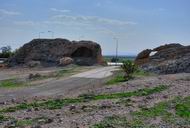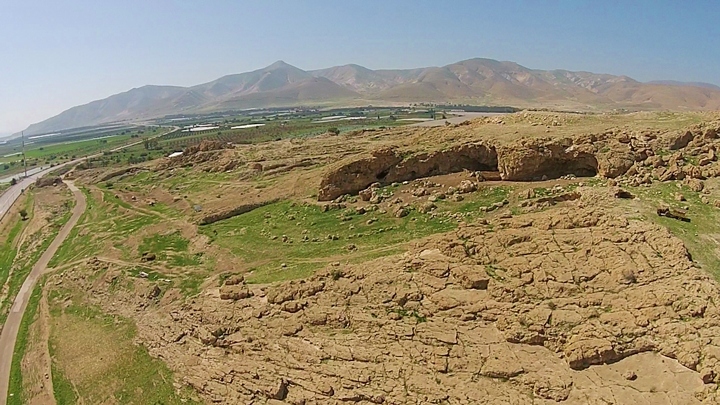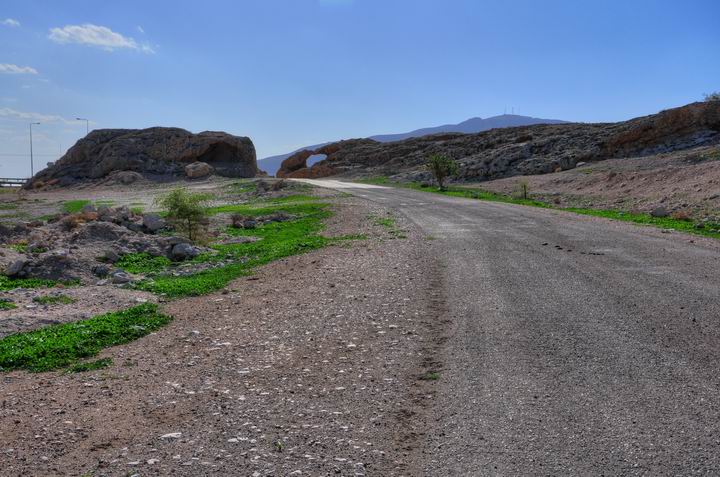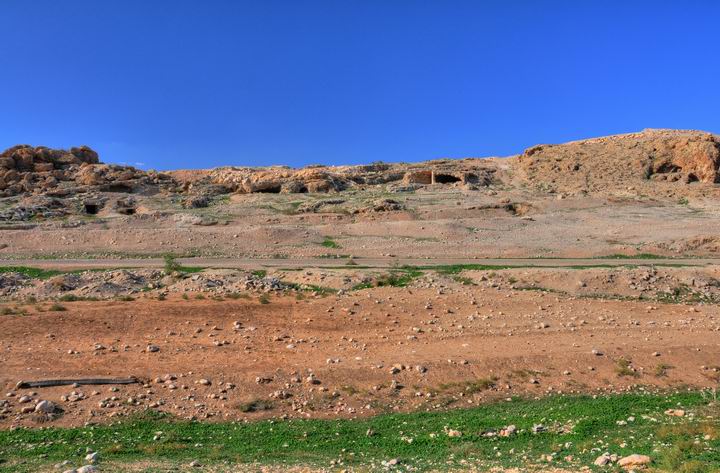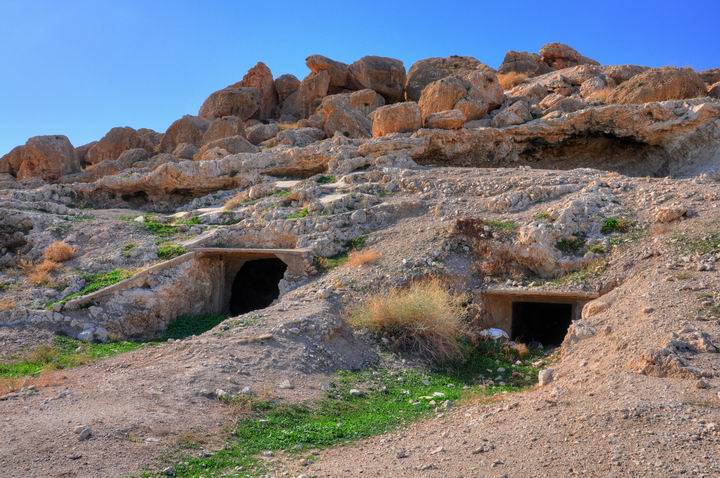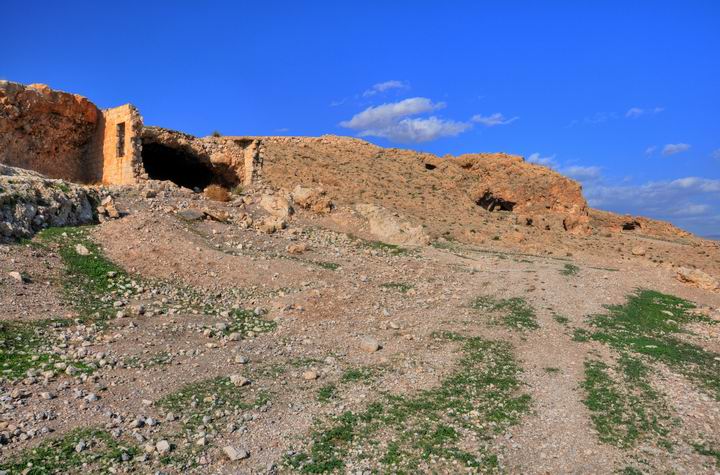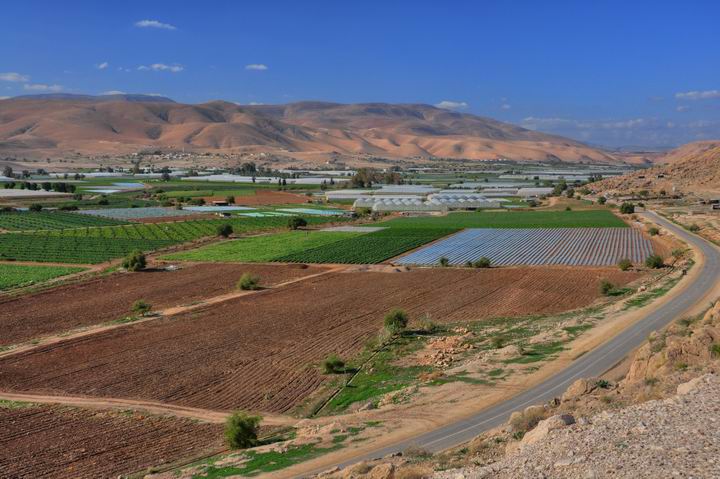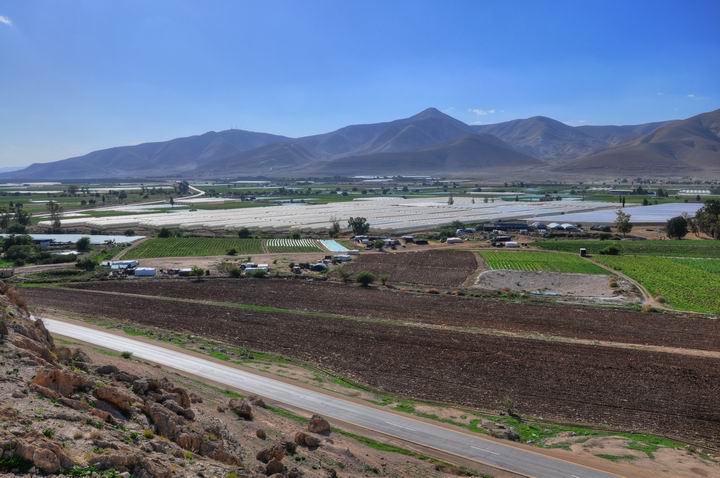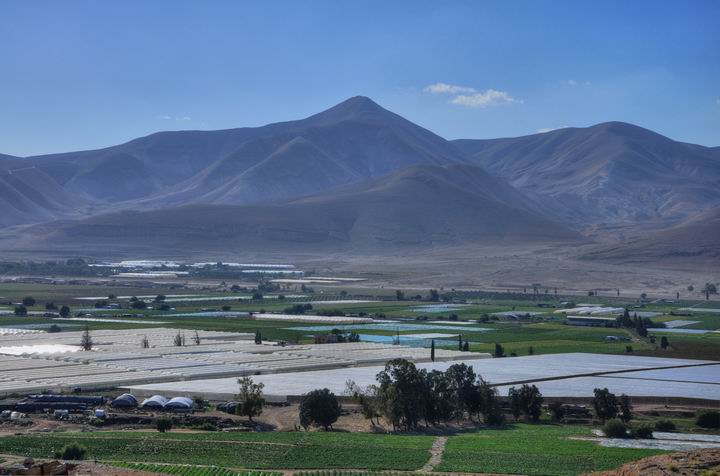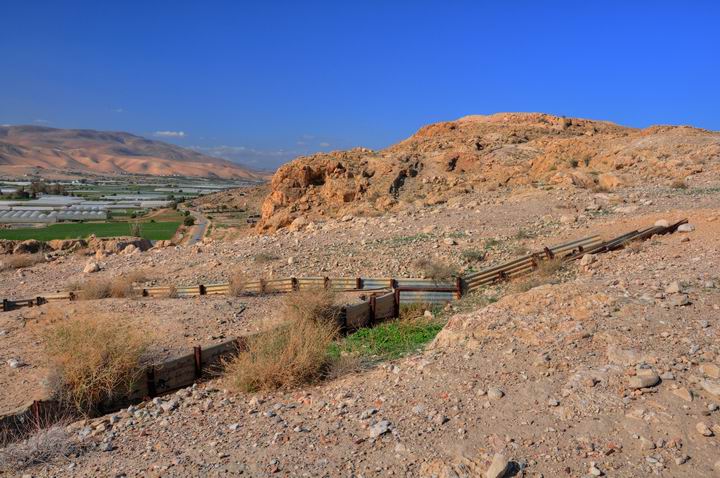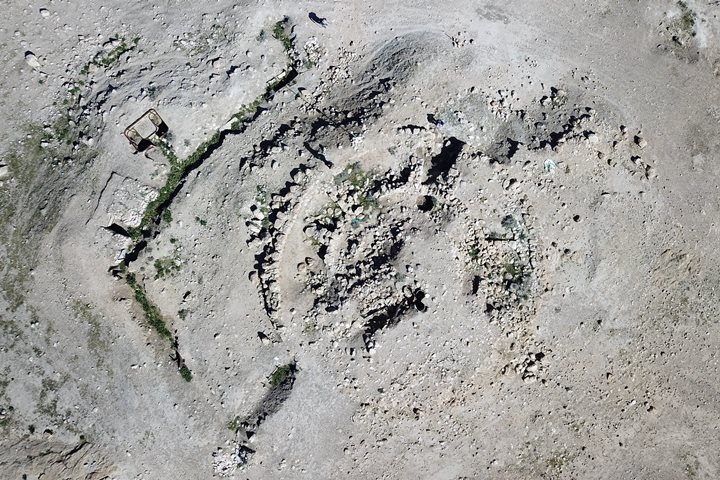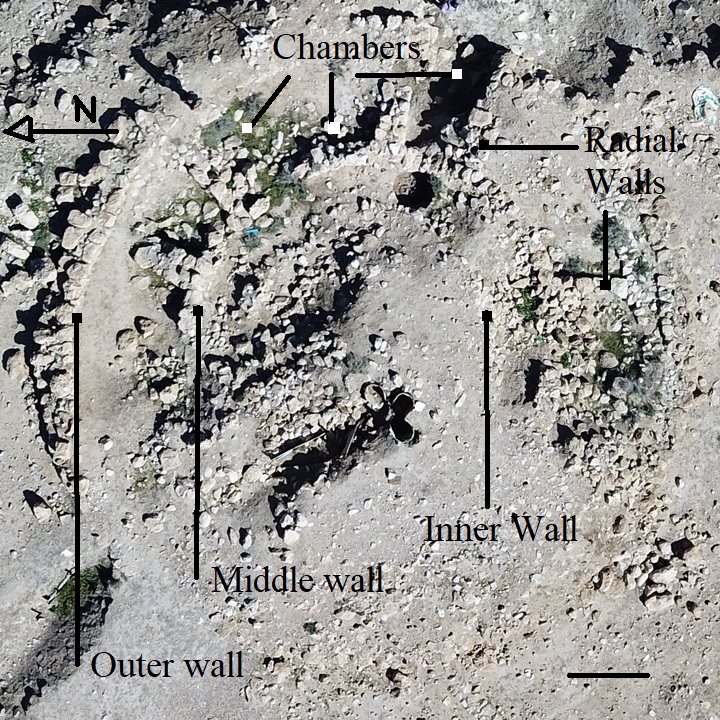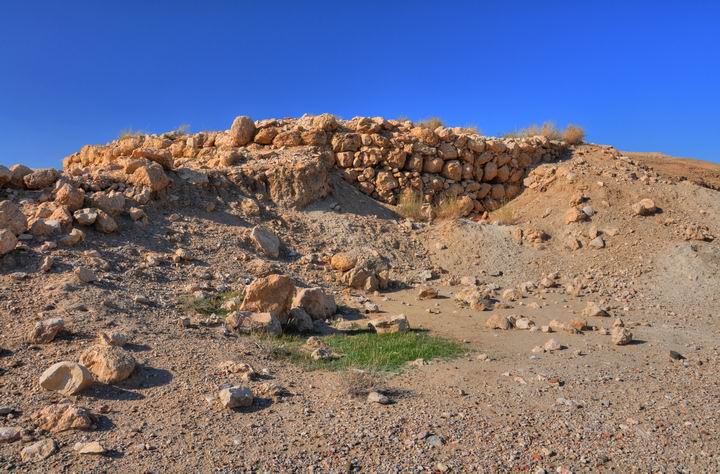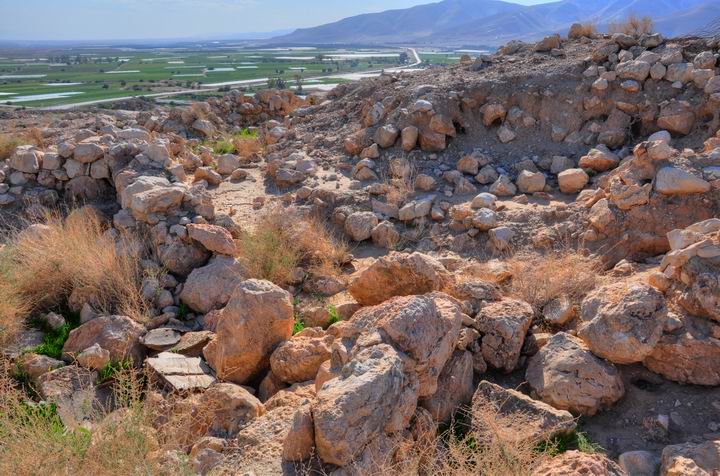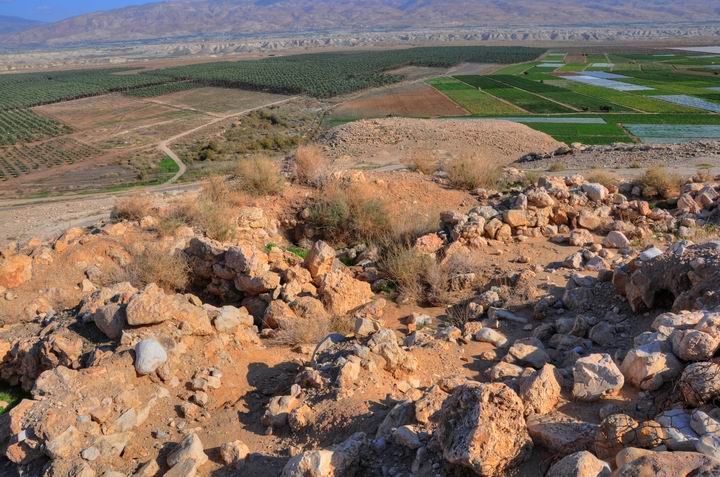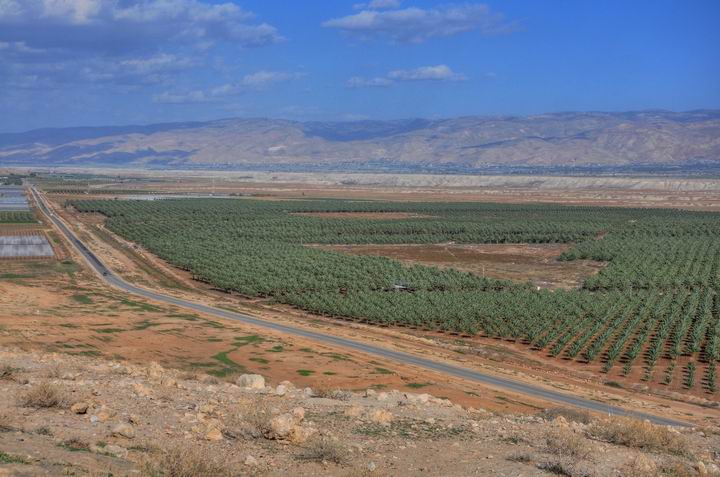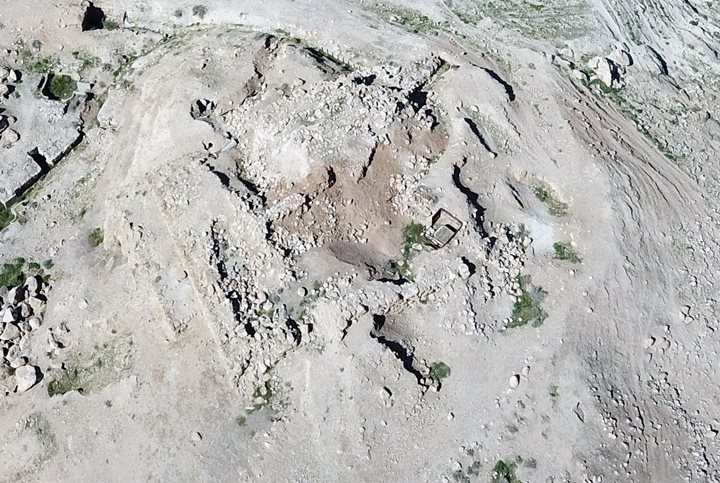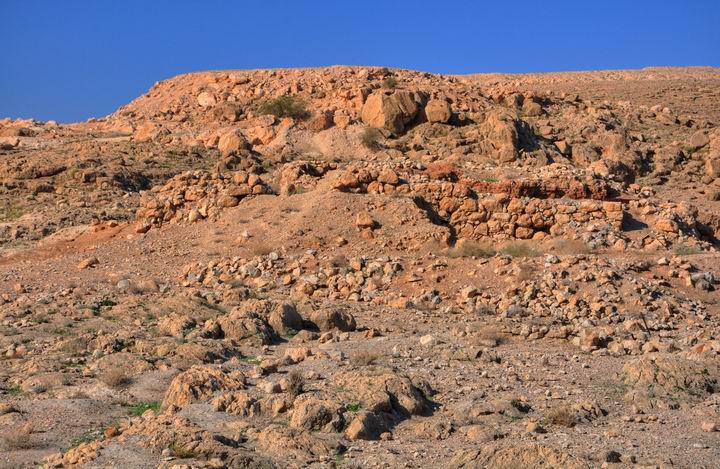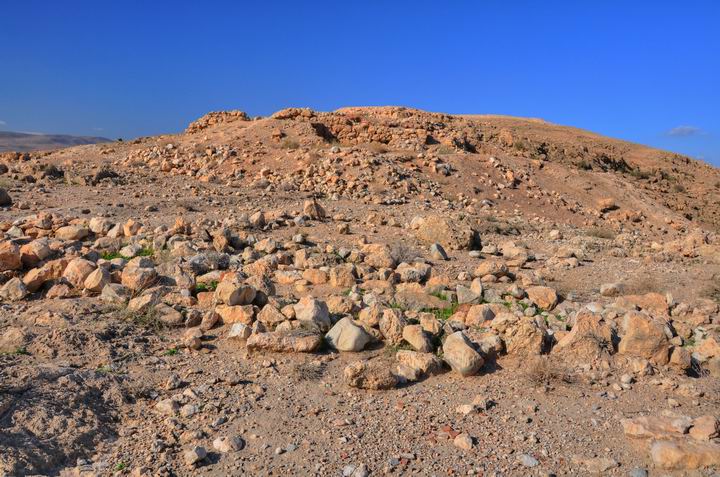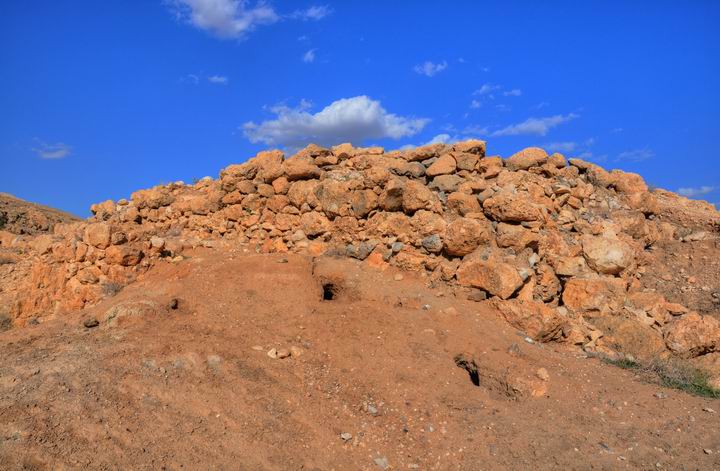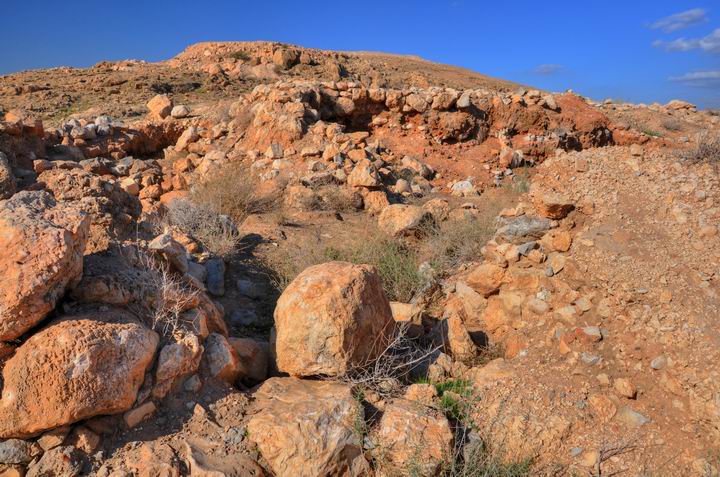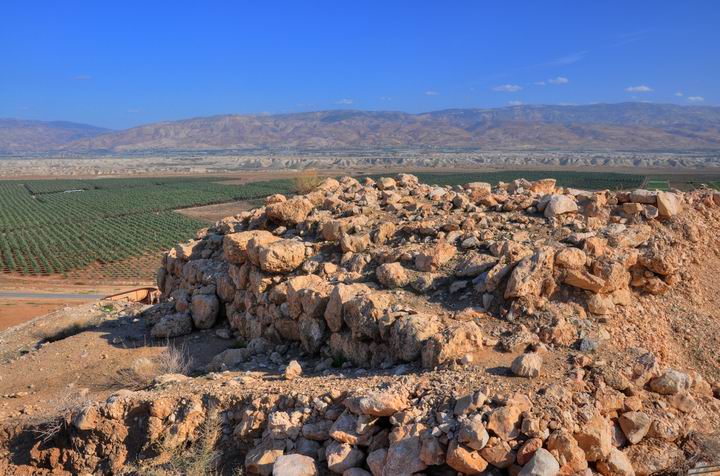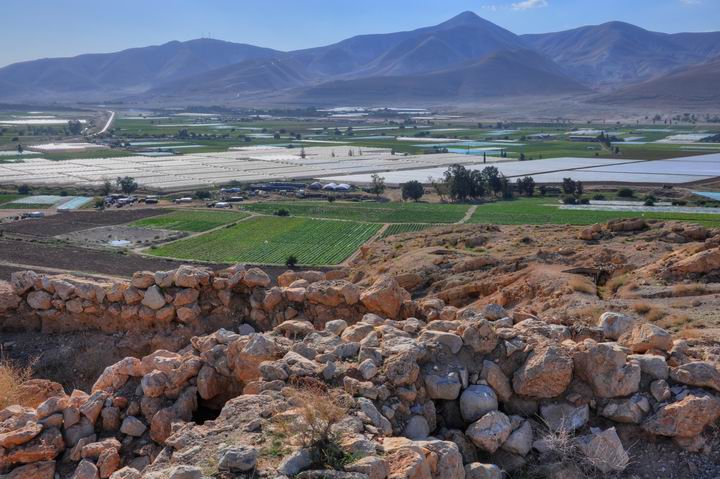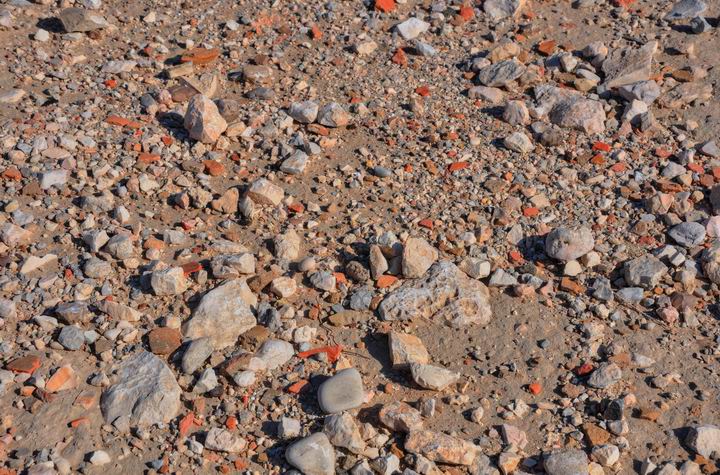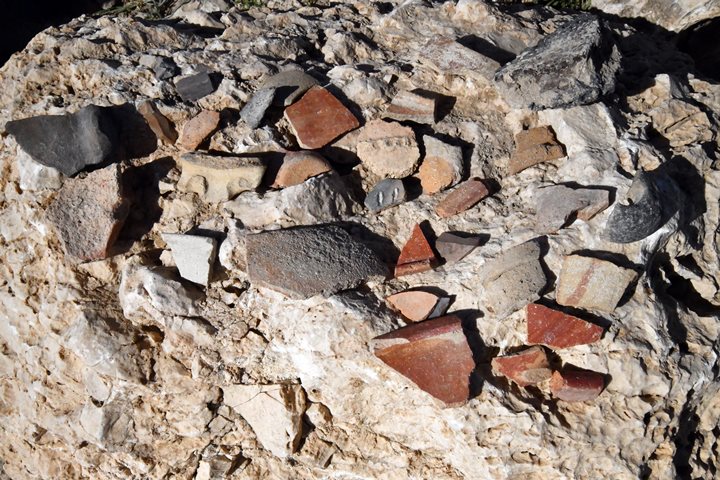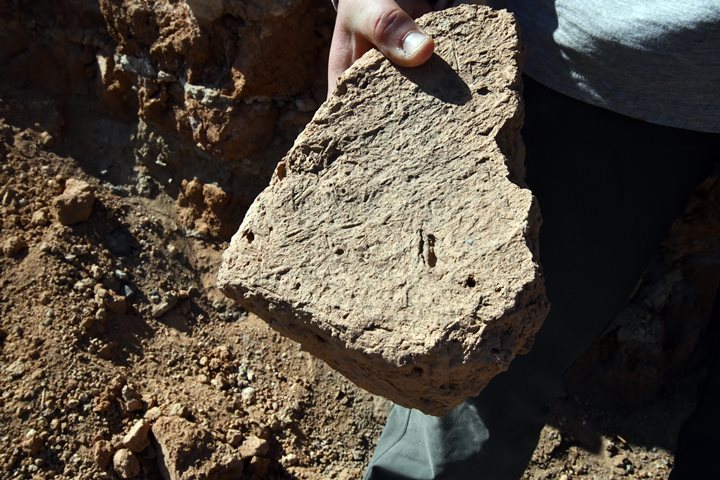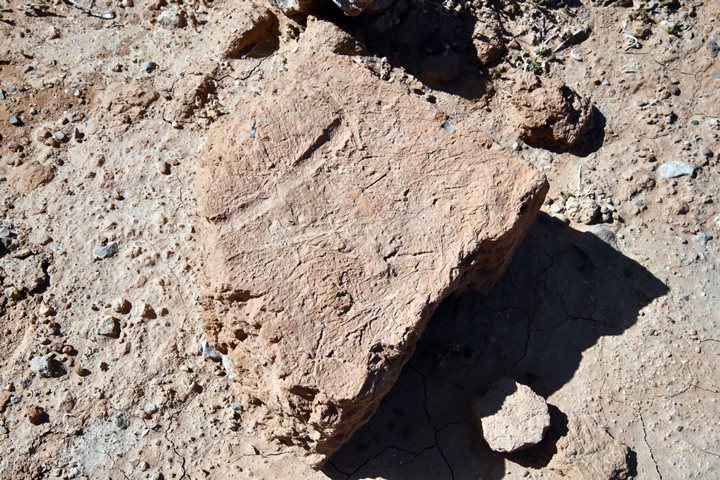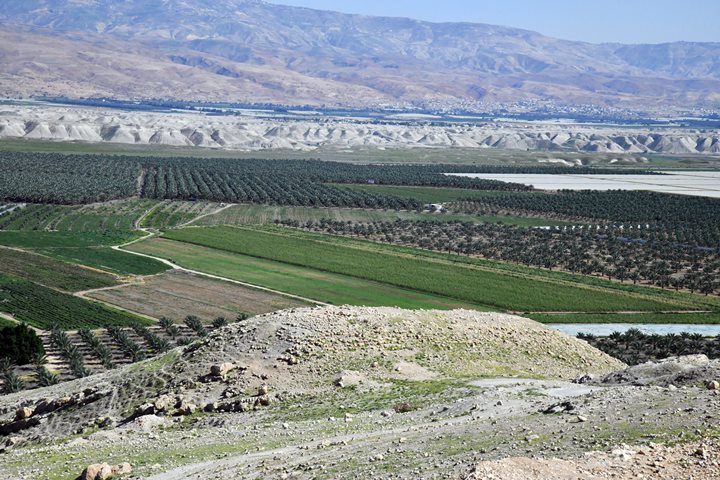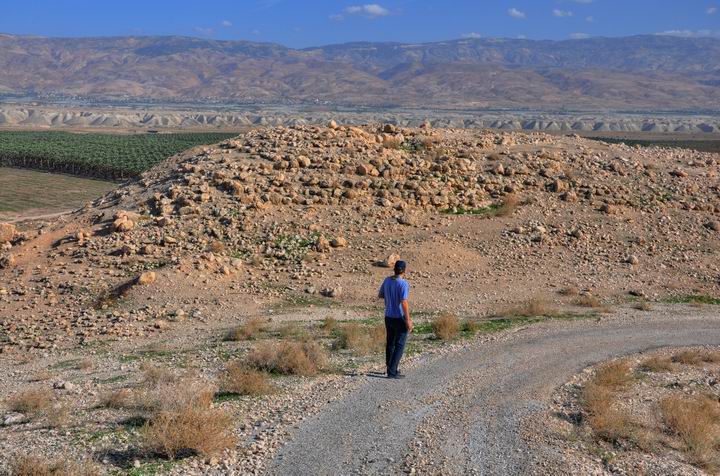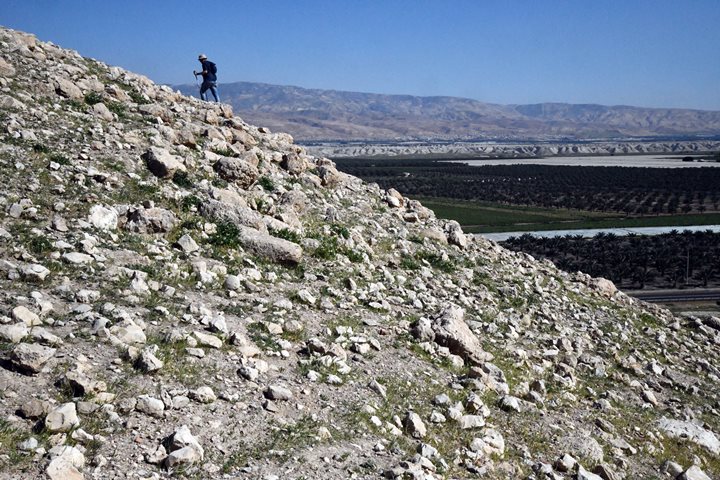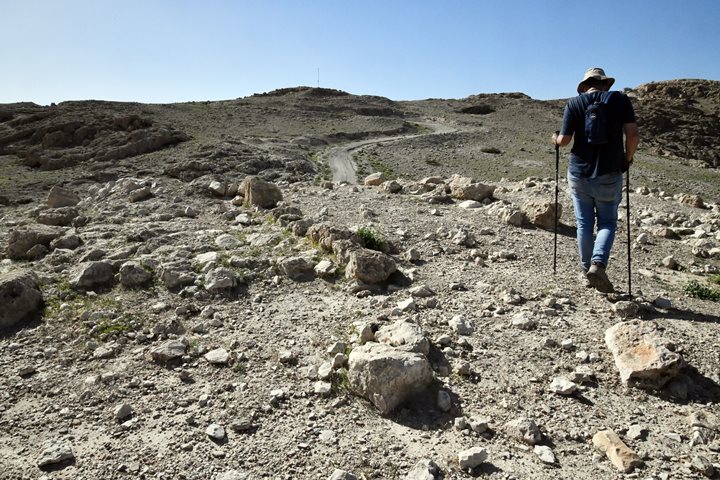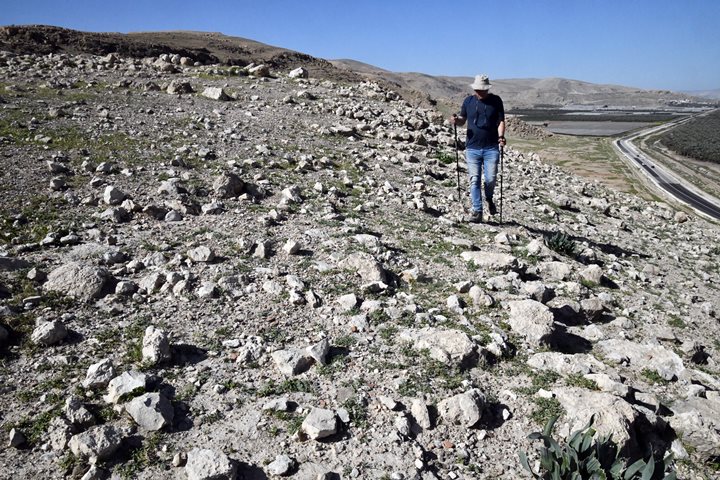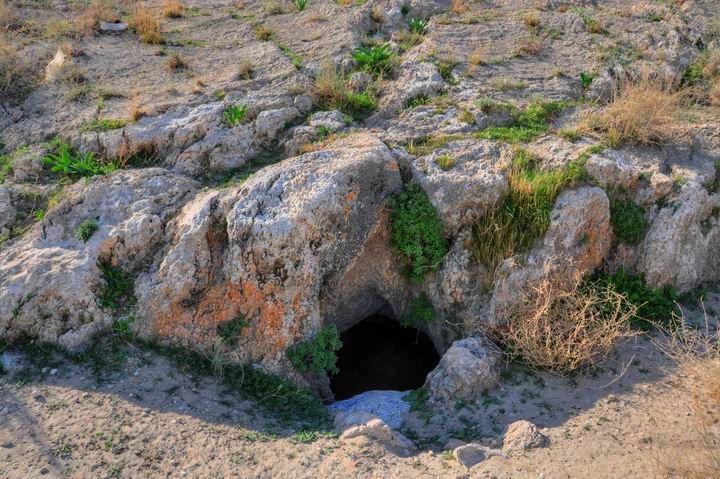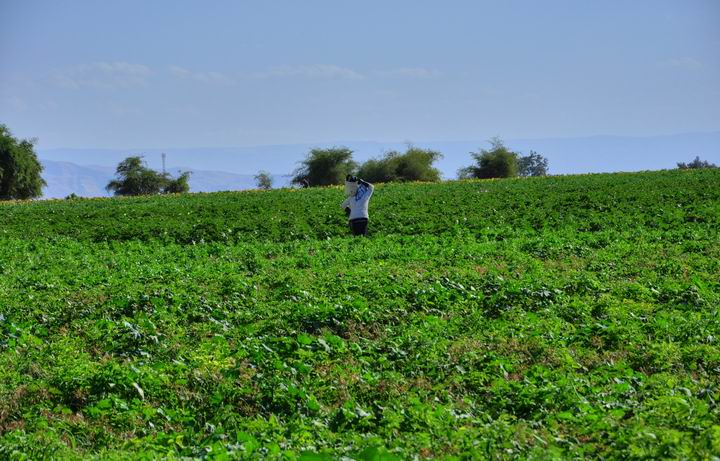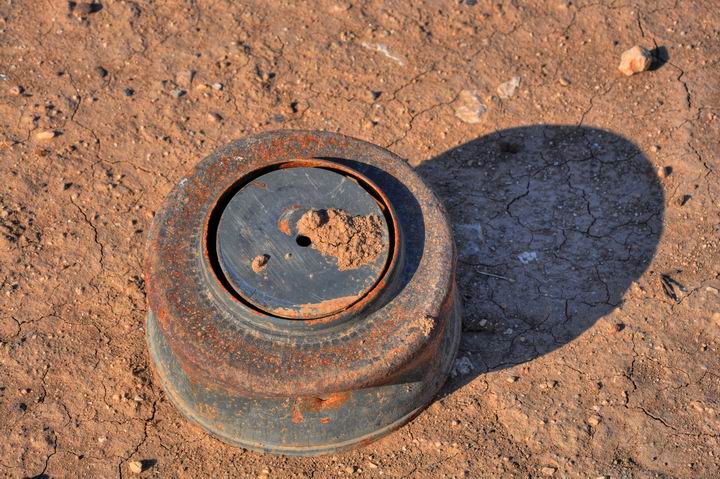Ruins of a large Early Bronze Canaanite fortified city and fortresses from the Israelite Kingdom period, located on a ridge overlooking the Jordan and Tirza (Farha) valleys.
Home > Sites > Jordan Valley> Khirbet Makhruk
Contents:
Overview
Aerial Map
History
Structure
Photos
* Aerial views
* Valley road
* Tirzah road
* South fortress
* NW structure
* Findings
* Eastern fort
* Fields
Links
References
Etymology
Background:
Ruins of a large Early Bronze Canaanite fortified city and fortresses from the Israelite Kingdom period. The site is located on a broad ridge, at the crossing of the Jordan valley and Tirza (Farha) valleys. The ruins date to the Early Bronze age and the Iron age II.
Map / Aerial View:
The site is located at a height of -247m, 30m above the valley surface, and covers 45 Dunams (11.25 acres). An aerial photo of the area around Khirbet Makhruk is shown below, indicating the major points of interest.
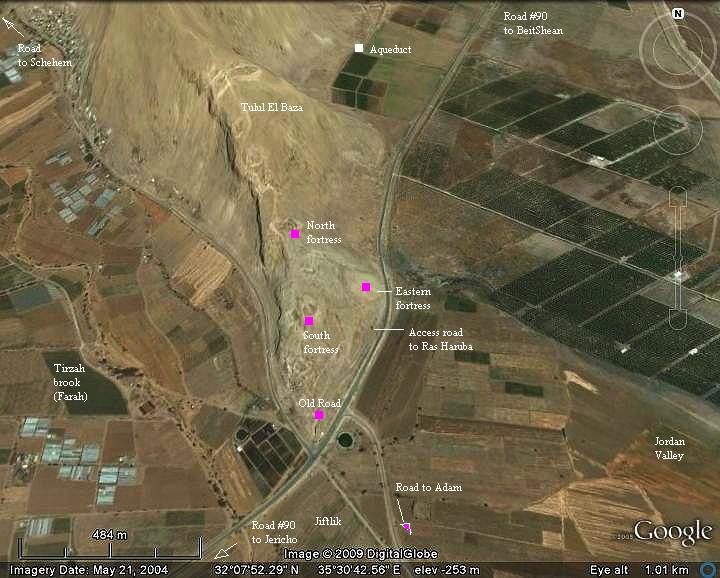
History:
-
Early Bronze age
During the Early Bronze age a fortified city covered most of the area of the ridge. The shape of the walled city was triangular, with the head of the triangle pointing north. A square fortified structure, dated to this period, was located on the highest edge of the fortified city.
-
Biblical period – Iron Age II
During the Israelite Kingdom, a rectangular fortress was rebuilt on the eastern hill and a circular tower in the southern part of the ridge. These fortifications served as a road fortress that protected the westward roads to the heart of the kingdom – Samaria.
According to Israel Guide (Judea/Jordan valley section, p286) the fortifications may have been conducted by Jeroboam, the first King of Northern Israelite Kingdom, in order to protect the route to the frontier city of Penuel, on the northern bank of Yabok (Zarka) brook, which passed at this place (1 Kings 12 25): “Then Jeroboam built Shechem in mount Ephraim, and dwelt therein; and went out from thence, and built Penuel”.
-
Roman Period
The site is located on a junction of two major roads. This was the case in ancient times as well as in the modern period. The Romans, masters of road construction, constructed a major “highway” that connected Jericho to Beit Shean (see below) and a road that connected this road and passed westward via Tirzah valley.
The Peutinger Map (Tabula Peutingeriana) is a medieval map which was based on a 4th C Roman military road map. The map shows the major roads (in brown lines), with indication of the cities, and geographic highlights (lakes, rivers, mountains, seas). Along the links are stations and distance in Roman miles (about 1.5KM per mile).
In this section of the map is the area of Jordan valley, drawn in a rotated direction (Dead sea is on the left; Sea of Galilee is the right).
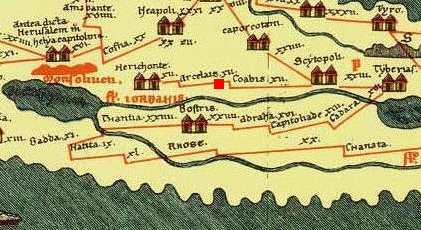
The major Roman road in the Jordan valley connected Beit Shean (“Scytopoli”) and Jericho (“Herichonte”). The red square marks the place of Khirbet Makhruk, in the middle between theses major cities.
-
Modern times
The site was damaged by modern armies; fortifications constructed by the Israeli Defense Forces (IDF). Communication lines and trenches were built into the circular and square towers, and in other parts of the ridge.
The site is an open area today, and is easily accessed. It is recommended to make a stop here, visit the site, and enjoy the views of the Jordan and Tirzah / Far’ah valleys.
Structure:
A diagram of the site is shown below (based on Manasseh Hill country survey), with indication of the position of the rectangular fort, circular tower and square structure. A paved road traverses the ridge, and continues on to the top of the ridge (Ras El Harubeh, a view point at a height of +211m, with great views of the Tirzah valley).
Early Bronze period:
The dashed line marks the area within the walls of the Early Bronze period city. The archaeologists identified 4 layers dated to the Early Bronze I and Early Bronze II-III. On the north side of this area was a large fortress built of red bricks. It was later reused during the Iron age (a square area marked as “Structure”). Around it were residential houses. A city was built on a mound on the east side was also built during the Early Bronze (marked as a rectangular fort).
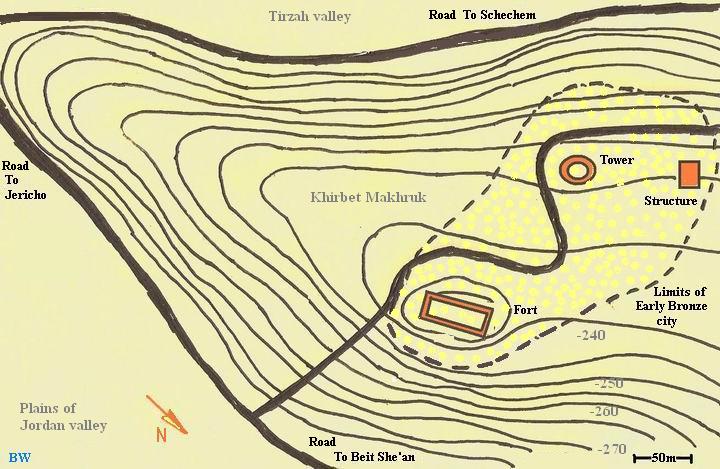
Iron Age II:
During the Iron Age II, three fortresses were built – a square tower above the Early Bronze structure on the NW side, a round tower on the south side, and a rectangular fortress above the Early Bronze mound on the east side. Around the fortresses there is no Iron Age settlement, so the purpose of the fortresses during this time was watch towers.
But why build 3 watch towers at the same time (Iron Age)? Since the construction of the round tower preceded the square tower, the hypothesis the excavators made was that the circular tower was abandoned and went out of use and was replaced by the square tower. They also suggested that the round tower was built by the Ahab, while the square tower was built by Jehoahaz, both of the Northern Kingdom, during their struggle with Aram Damascus.
Photos:
(a) Aerial Views:
A drone captured views above the site in Feb 2016. The eastern fortress is located on a hill, in the center of the view, just above road #90 (Beit Shean to Jericho). The green farming areas, in the plains of the Jordan valley, are on the right (east) side.
An access road climbs up to the top of the ridge, passing near the circular tower and the square structure which are located up the road.
Click on the photos to view in higher resolution…
A drone from a photo above the eastern side of the site captured this photo, with a view towards the south. The green valley of Tirzah is seen behind the hill, and leads to the right towards Shechem. The fortified hill of Sartaba, a pointed hill that towers above the mountains on the south side of the entrance to the valley, is in the center background. A number of caves were inhabited on the eastern cliffs.
![]() The following YouTube video shows a flight Kh. Makhruk, then turning around to view the surrounding area:
The following YouTube video shows a flight Kh. Makhruk, then turning around to view the surrounding area:
This video was captured on March 2023
(b) Valley Road and caves:
The old north-south road passed at the southern edge of the ridge. The new #90 road was relocated slightly eastwards, as seen on the left side.
The photo below shows a closer view of the rock formations on both sides of the old road. This split rock formation may have given the name of the site – el-Makhruk means “perforated” in Arabic (according to Z. Vilnai).
The eastern side of the ridge is pocketed with caves and traces of ruins. The caves were used for residential and farming purposes.
Below is a closer view of modern fortifications in the caves along the eastern side. This was the site of the Ottoman’s 53rd division headquarters in WW1 (1918), and the British managed to capture it during its offensive in Israel on their attack towards Jordan.
The photo below – another view of the eastern side.
(c) Tirzah Road:
The road on the south side of the ridge is an ancient route from the Jordan to the heart of Samaria. This is the valley of Tirzah (Far’ah).
Tirzah, the name of the valley, was Biblical city in Samaria. It was once a mighty Canaanite city (Joshua 12 24):
“And these are the kings of the country which Joshua and the children of Israel smote… the king of Tirzah”.
It then became Israel’s Kingdom first capital city (1 Kings 15 33):
“In the third year of Asa king of Judah began Baasha the son of Ahijah to reign over all Israel in Tirzah, twenty and four years”.
The pointed hill is the place of the fortress of Sartaba, identified as Biblical Zarthan. According to the Bible, King Solomon prepared Brass and Gold vessels for the temple, casting them in the clay that is located here between Succoth (plains of valley of Jordan) and Zarthan (1 Kings 7:47):
“In the plain of Jordan did the king cast them, in the clay ground between Succoth and Zarthan”.
So the casting of the temple tools was done at this area.
The ridge was heavily fortified in modern times, since even today it is strategically located on an important junction. The communication lines in the picture below cut through the ridge and damaged the site.
(d) South Fortress – Circular tower:
A small fortress is located in the south side of the site, as marked in red on the diagram of the site.
The tower has an external diameter of 19.5m, and consists of 3 concentric towers. According to the excavator (Yeivin 1993), it is dated to the 10th-9th century BC (Iron Age II), with some underlying Early Bronze remains. The tower was damaged by modern military construction, but the archaeologists managed to research the structure and restore some of its sections.
An aerial view of the circular tower is below, with a view towards the east:
The circular tower has 3 concentric stone walls, as seen in the legend below. Here is the plan of the structure:
- An inner circular tower of 8m in diameter, built as a solid area full of stones and pottery fragments, within a supporting stone wall 70cm wide and at least 2m deep.
- A second stone wall, 10m in diameter, was built around the inner circular tower, with a space of 1m. The space to the inner wall was filled with sun-dried mud bricks.
- An outer stone wall, 19.5M in diameter, was built around the middle circular wall with a space of 2m. The wall is 1m wide.
- Casemate plan: The space between the two external stone walls had radial walls that created chambers. An opening of 60-70cm in the radial walls allowed moving between the chambers.
- Pottery of the 9th century BC were found on the floors of the radial chambers. One of these rooms had an oven.
Ground views:
The ruins of the tower is shown here, as captured from the south side.
A closer view of the eastern side of the tower is seen below, as seen from the north side. Notice the 3 walls of this concentric tower, and a section of a radial wall on the right side.
Standing on the tower, the Biblical time watchmen could see the eastern rectangular fortress below, and a great view of the plains of the Jordan valley. The watchmen would have spotted enemy troops approaching from the Jordan and alerted the army.
The tower also provides a great view of the road to the north and the plains of the Jordan valley. The Biblical name of this area was “Succoth”.
(e) North-West side – Square structure:
A square fortified structure was located on the highest edge of the fortified city- the north-west side. Its location inside the site appears on the diagram, marked in red.
According to the excavator (Yeivin 1993), it is dated to the 10th-9th century BC (Iron Age II), built slightly later than the circular tower. The fortress was built over the ruins of the Bronze period fortress.
An aerial view of the square structure is seen here, oriented towards the north. Around the tower are modern military trenches. Most of the structure was damaged by erosion and/or Military construction, so only the north-east side was partially intact when the structure was unearthed.
A closer view of the square fortress is in the following aerial view. The Iron Age fortress area is 23m x 18m, built over the Early Bronze structure,. It was constructed in two phases. The first phase was a smaller fortress (10m x 15m), and it was later expanded. The plan of the second phase was a central courtyard with rooms around it. The rooms were 2m x 1m, with thin internal walls (70cm) and a wider external wall (2m).
Ground views:
The photo below shows the square structure, as seen from the circular tower.
Another view of the square structure is in the picture below. A section of the Early Bronze period wall stretches in front – from left to right.
A closer view of the walls of this structure is in the picture below. The building was first constructed with an area of 15 x 10m, then enlarged to 24 x 20m.
The picture below shows the interior of the square structure.
A north-east view of the plains of the Jordan valley is seen from the structure.
The view towards the south is remarkable. The green valley of Tirzah (Far’ah), and the high mountains of above the valley, with the pointed hill of Sartaba (identified as the Biblical Zarthan).
(f) Pottery and flint findings:
The site is covered by a blanket of red/orange ceramic fragments. The majority of these are dated to the Bronze and Iron ages with almost no later period ceramics.
We collected some of the interesting pottery segments and flint tools. All items were left on the site.
According to Zartal’s site description, the ceramics in Kh. Makhruk were dated to the Chalcolithic period (4%), Early Bronze I (5%), Early Bronze 2-3 (65%), Middle Bronze 2B (2%), and Iron age (24%). The flint tools were dated to the Neolithic pottery period (Wadi Rabah culture), Chalcolithic, and Early Bronze period.
Sun dried mud bricks, dated to the Iron Age, are found in Khirbet Makhruk. Example:
Some of the mud bricks were burnt during the destruction, and could be dated by archaeomagnetic dating method.
(g) Eastern Fortress:
A second rectangular Iron Age II fortress is located on the east side, closer to highway #90. It was built over an earlier Early Bronze mound.
Its location is marked in red in the diagram.
The photo below shows the fortress from the west side. In the background of the photo are the plains of the Jordan valley, in the direction of Adam bridge.
A closer view of the rectangular Iron Age II fortress. It is protected by a very wide (4m) wall.
The mound is steep:
On the summit of the rectangular fortress are traces of walls. This view is towards the west, where the round and square towers are built.
Another view towards the north:
A water cistern is located near the fortress, and was part of the water supply for the city and fortress.
(h) The Fields:
The green fields near the road present a vivid contrast to the dry light-brown soil around it. Local Arab villagers work the fields in old fashion ways – by hand.
An old mine was seen near this field. After all, the area is close to the border and is a gateway for two major crossing roads. The mine was probably found during the farming of the field, and left out on the road. Since it is painted blue, this might be a dummy training mine, but we would not advise to touch it.
Links:
- Where is Coabis? (Adam Zertal, 1991; Hebrew) – discussion on Roman roads in the Jordan valley
References:
-
- Studies in the Archaeology of the Iron Age in Israel and Jordan (edited A. Mazar, 2001, ISBN 1-84127-203-5)
Chapter 2: Adam Zertal (pp 38-64): The heart of the Monarchy: Pattern of settlement and Historical considerations of the Israelite Kingdom of Samaria Preview
- Manasseh Hill country survey Vol 2 Eastern Valleys Site 269 el-Makhruq Preview
- “From Watchtowers to Fortified Cities” — On the History of Highway Forts in the Israelite Kingdom” -A. Zartal, Qadmoniot 1988), pp. 82-86 (5 pages)
- Three Iron Age Fortresses in the Jordan Valley and the Origin of the Ammonite
Circular Towers – Israel Exploration Journal , 1995, Vol. 45, No. 4 (1995), pp. 253-273
* Biblewalks sites:
- Drone Aerial views – collection of Biblical sites from the air
- esh-Shukk valley – similar Iron Age circular tower
- Rujm Abu Mukheir – another Iron Age circular tower
- Sun dried mud bricks
Etymology – behind the name:
-
Makhruk (Mahruq, Makherouk)- Arabic for “split”. The name of the site, based on the split between the rocks where the road passed.
- Mukhrak (Muhraq) – Arabic for: “burnt” . Another common interpretation of the name of the site.
- Khirbet – Ruined site in Arabic;
-
Khurvah (Horvah, Horbah )- Ruined site in Hebrew; Khirbet in Arabic. Biblical references: Leviticus 26,31: “And I will make your cities waste,…”. Isaiah 44, 26: “…and I will raise up the decayed places thereof.
-
Tirzah – Biblical city in Samaria – Once a Canaanite city (Joshua 12 24: “And these are the kings of the country which Joshua and the children of Israel smote… the king of Tirzah”), and then Israel’s Kingdom first capital city (1 Kings 15 33: “In the third year of Asa king of Judah began Baasha the son of Ahijah to reign over all Israel in Tirzah, twenty and four years”).
- Tirzah brook – The brook from Shechem to Adam.
- Farah – The name in Arabic of Tirzah; unknown translation.
- Jiftlik, Jiftliq – Turkish: The Sultan’s estate. There were many such estates, one is located south-east of Makhruk.
BibleWalks.com – walks along the Jordan river
Adam<<<—previous site—<<<All Sites>>>—next Jordan Valley site—> >> Jordan-Jericho
This page was last updated on July 29, 2024 (add round towers links)
Sponsored Links:
